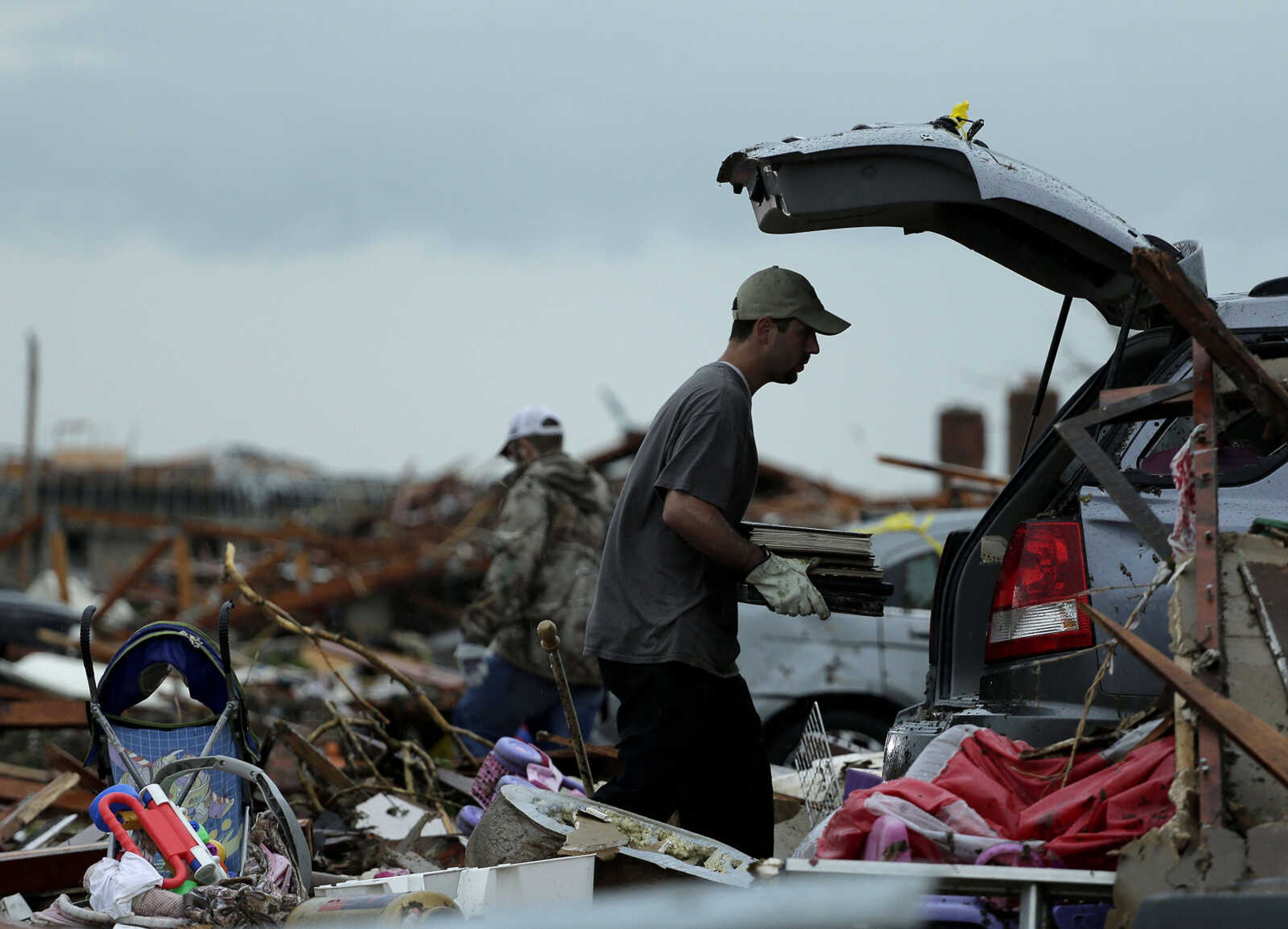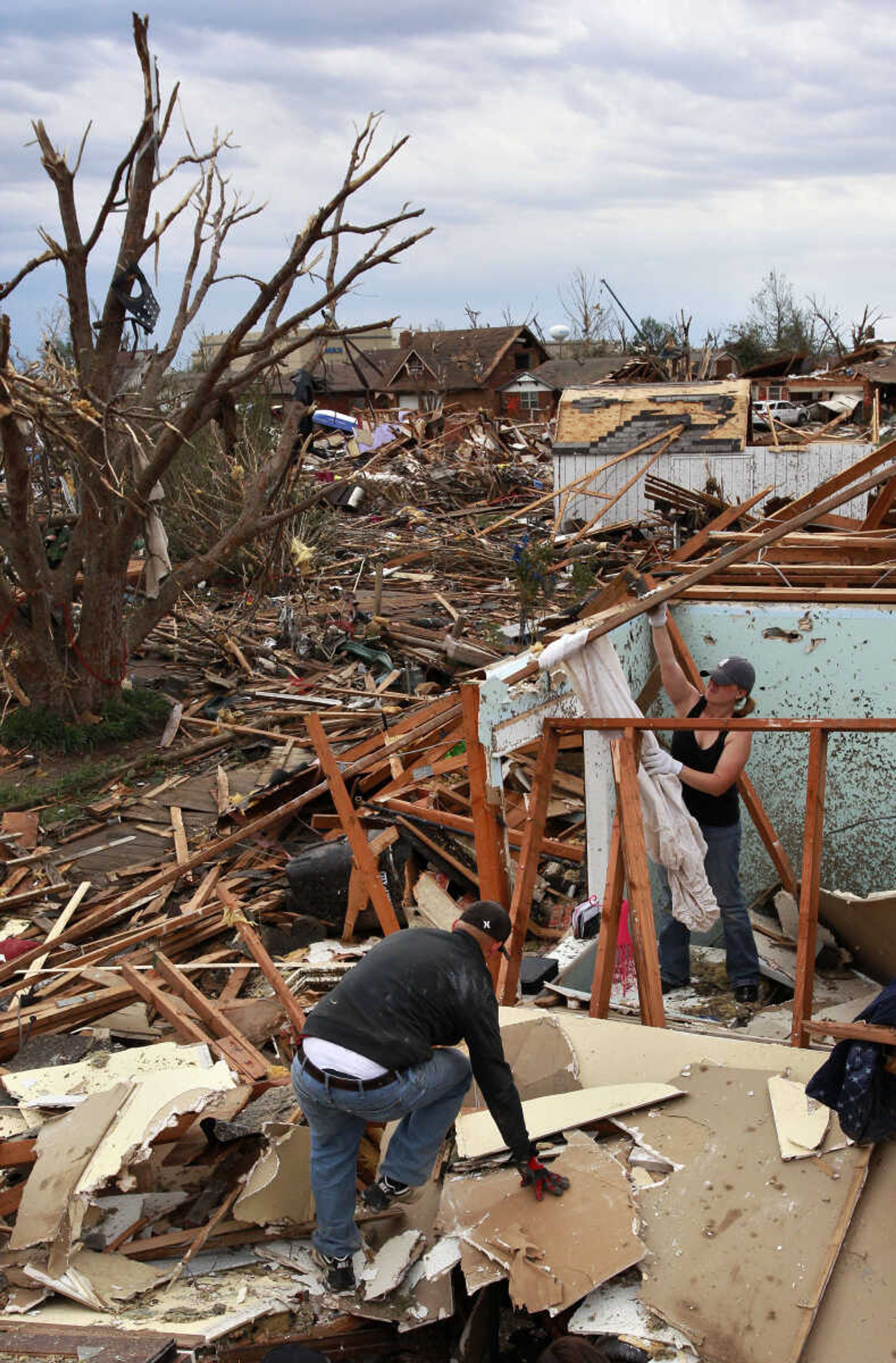Search nearly complete after Oklahoma tornado
MOORE, Okla. -- Helmeted rescue workers raced Tuesday to complete the search for survivors and the dead in the Oklahoma City suburb where a mammoth tornado destroyed countless homes, cleared lots down to bare red earth and claimed 24 lives, including those of nine children...
MOORE, Okla. -- Helmeted rescue workers raced Tuesday to complete the search for survivors and the dead in the Oklahoma City suburb where a mammoth tornado destroyed countless homes, cleared lots down to bare red earth and claimed 24 lives, including those of nine children.

Scientists concluded the storm was a rare and extraordinarily powerful type of twister known as an EF5, ranking it at the top of the scale used to measure tornado strength. Those twisters are capable of lifting reinforced buildings off the ground, hurling cars like missiles and stripping trees completely free of bark.
Residents of Moore began returning to their homes a day after the tornado smashed some neighborhoods into jagged wood scraps and gnarled pieces of metal. In place of their houses, many families found only empty lots.
After nearly 24 hours of searching, the fire chief said he was confident there were no more bodies or survivors in the rubble.
"I'm 98 percent sure we're good," Gary Bird said at a news conference with the governor, who had just completed an aerial tour of the disaster zone.
Authorities were so focused on the search effort they had yet to establish the full scope of damage along the storm's long, ruinous path.
They did not know how many homes were gone or how many families had been displaced. Emergency crews had trouble navigating devastated neighborhoods because there were no street signs left. Some rescuers used smartphones or GPS devices to guide them through areas with no recognizable landmarks.
The death toll was revised downward from 51 after the state medical examiner said some victims may have been counted twice in the confusion. More than 200 people were treated at area hospitals.
By Tuesday afternoon, every damaged home had been searched at least once, Bird said. His goal was to conduct three searches of each building to be certain there were no more bodies or survivors.

The fire chief was hopeful that could be completed before nightfall, but the work was being hampered by heavy rain. Crews also continued a brick-by-brick search of the rubble of a school that was blown apart with many children inside.
No additional survivors or bodies have been found since Monday night, Bird said.
Survivors emerged with harrowing accounts of the storm's wrath, which many endured as they shielded loved ones.
Chelsie McCumber grabbed her 2-year-old son, Ethan, wrapped him in jackets and covered him with a mattress before they squeezed into a coat closet of their house. McCumber sang to her child when he complained it was getting hot inside the small space.
"I told him we're going to play tent in the closet," she said, beginning to cry.
"I just felt air so I knew the roof was gone," she said Tuesday, standing under the sky where her roof should have been. The home was littered with wet gray insulation and all of their belongings.
"Time just kind of stood still" in the closet, she recalled. "I was kind of holding my breath thinking this isn't the worst of it. I didn't think that was it. I kept waiting for it to get worse."
"When I got out, it was worse than I thought," she said.
Gov. Mary Fallin lamented the loss of life, especially the children who were killed, but she celebrated the town's resilience.
"We will rebuild, and we will regain our strength," Fallin said.
In describing the bird's-eye view of the damage, the governor said many houses were "taken away," leaving "just sticks and bricks, basically. It's hard to tell if there was a structure there or not."
From the air, large stretches of town could be seen where every home had been cut to pieces. Some homes were sucked off their concrete slabs. A pond was filled with piles of wood and an overturned trailer.
Also visible were large patches of red earth where the tornado scoured the land down to the soil. Some tree trunks were still standing, but the winds ripped away their leaves, limbs and bark.
In revising its estimate of the storm's power, the National Weather Service said the tornado had winds of at least 200 mph and was on the ground for 40 minutes.
The agency upgraded the tornado from an EF4 on the enhanced Fujita scale based on reports from a damage-assessment team, said spokeswoman Keli Pirtle. Monday's twister was at least a half-mile wide. It was the nation's first EF5 tornado of 2013.
Other search-and-rescue teams concentrated on Plaza Towers Elementary, where the storm ripped off the roof, knocked down walls and destroyed the playground as students and teachers huddled in hallways and bathrooms.
Seven of the nine dead children were killed at the school, but several students were pulled alive from under a collapsed wall and other heaps of mangled debris. Rescue workers passed the survivors down a human chain of parents and neighborhood volunteers. Parents carried children in their arms to a triage center in the parking lot. Some students looked dazed, others terrified.
Neither Plaza Towers nor another school in Oklahoma City that was not as severely damaged had reinforced storm shelters or safe rooms, said Albert Ashwood is director of the Oklahoma Department of Emergency Management.
More than 100 schools across the state do have safe rooms, he said, explaining that it's up to each jurisdiction to set spending priorities.
Ashwood said a shelter would not necessarily have saved more lives at Plaza Towers.
"When you talk about any kind of safety measures ... it's a mitigating measure, it's not an absolute," he told reporters. "There's not a guarantee that everyone will be totally safe."
Officials still were trying to account for a handful of children not found at the school who may have gone home early with their parents, Bird said.
On the streets of Moore, evidence of the storm's fury stretched in every direction: Roofs were torn off houses, exposing metal rods left twisted like pretzels. Cars sat in heaps, crumpled and sprayed with caked-on mud. Insulation and siding was piled up against any walls still standing. Yards were littered with pieces of wood, nails and pieces of electric poles.
President Barack Obama pledged to provide federal help and mourned the death of young children who were killed while "trying to take shelter in the safest place they knew -- their school."
The town of Moore "needs to get everything it needs right away," he said Tuesday.
Moore has been one of the fastest-growing suburbs of Oklahoma City, attracting middle-income families and young couples looking for stable schools and affordable housing. The town's population has grown over the last decade as developers built subdivisions for people who wanted to avoid the urban problems and schools of Oklahoma City but couldn't afford pricier Norman, the college town next door.
Many residents commute to jobs in Oklahoma City or to Tinker Air Force Base, about 20 minutes away.
------
Associated Press writers Tim Talley, Ramit Plushnick-Masti and Nomaan Merchant, and Associated Press photographer Sue Ogrocki contributed to this report.
Connect with the Southeast Missourian Newsroom:
For corrections to this story or other insights for the editor, click here. To submit a letter to the editor, click here. To learn about the Southeast Missourian’s AI Policy, click here.









